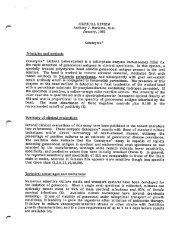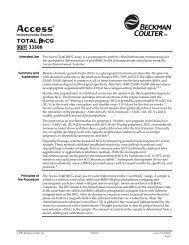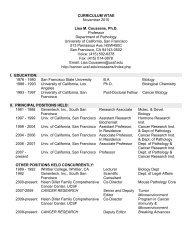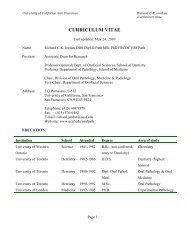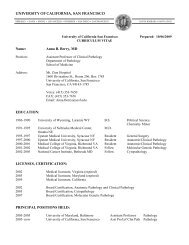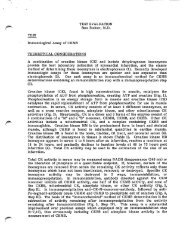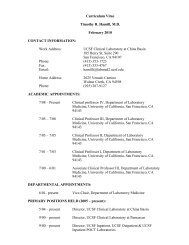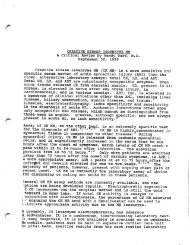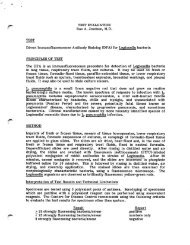Pattern Recognition in Practical Surgical Neuropathology
Pattern Recognition in Practical Surgical Neuropathology
Pattern Recognition in Practical Surgical Neuropathology
You also want an ePaper? Increase the reach of your titles
YUMPU automatically turns print PDFs into web optimized ePapers that Google loves.
PATTERN RECOGNITION IN SURGICAL<br />
NEUROPATHOLOGY<br />
Arie Perry, M.D.<br />
Director, <strong>Neuropathology</strong> Division<br />
DISCLOSURES<br />
• The lecturer will be utiliz<strong>in</strong>g portions of<br />
two commercial products <strong>in</strong> his talks<br />
− Textbook by A Perry and D Brat entitled<br />
“<strong>Practical</strong> <strong>Surgical</strong> <strong>Neuropathology</strong>”<br />
− CD by A Perry entitled “<strong>Neuropathology</strong><br />
Songs”<br />
• The lecturer receives royalties from the<br />
sales of these two products<br />
PATTERN RECOGNITION IMPERSONATORS
Beware: Look-alikes<br />
and Mimics
CLINICAL AND RADIOLOGICAL<br />
PATTERNS<br />
• Location<br />
• Location<br />
• Location<br />
• Patient Age<br />
• Radiology<br />
• Histologic <strong>Pattern</strong>s<br />
Real estate analogy<br />
≠ ≠<br />
≠
PATTERNS: EXAMPLE CASE<br />
• 48-yo F with a 7 year history of seizures<br />
and a non-enhanc<strong>in</strong>g R temporo-parietal<br />
mass that has been closely followed with<br />
serial imag<strong>in</strong>g<br />
• Recent imag<strong>in</strong>g demonstrated tumor<br />
growth and new foci of contrast<br />
enhancement, prompt<strong>in</strong>g surgery<br />
MRI<br />
T2 FLAIR T1-GAD
WHICH PATTERN(S)?<br />
• Parenchymal Infiltrate with Hypercellularity<br />
• Solid Mass (Pure)<br />
• Solid and Infiltrative Process<br />
• Vasculocentric Process<br />
• Extra-axial Mass<br />
• Men<strong>in</strong>geal Infiltrate<br />
• Destructive/Necrotic Process<br />
• Subtle Pathology or Near Normal Biopsy<br />
WHICH PATTERN(S)?<br />
• Parenchymal Infiltrate with Hypercellularity<br />
• Solid Mass (Pure)<br />
• Solid and Infiltrative Process<br />
• Vasculocentric Process<br />
• Extra-axial Mass<br />
• Men<strong>in</strong>geal Infiltrate<br />
• Destructive/Necrotic Process<br />
• Subtle Pathology or Near Normal Biopsy
*IDH1-R132H+ (70-80%)<br />
GFAP SYN
FISH STUDIES<br />
1p32<br />
1q42<br />
19p13<br />
19q13<br />
Neu-N IDH1-R132H<br />
DX: ANAPLASTIC<br />
OLIGODENDROGLIOMA,<br />
WHO GRADE III
AO GBM-SC OLIGODENDROGLIOMA (II or III)<br />
• Age 30-40 years<br />
• Corticotropism / seizures common<br />
• Cerebral, especially frontal lobe<br />
• Slow progression<br />
• Survival ~10 years for grade II, 2-5<br />
years for grade III<br />
• 5-25% of diffuse gliomas<br />
OLIGODENDROGLIOMA OLIGODENDROGLIOMA<br />
GFAP
Medical Education: CD<br />
Record<strong>in</strong>g<br />
• <strong>Neuropathology</strong> songs<br />
• Common disorders<br />
• 2 nd Year medical<br />
students<br />
• Memorization aid<br />
• Fun way to learn!<br />
www.neuropathsongs.com<br />
iTunes or amazon.com
Full Arrangements: Chris Bergmann – RFJ Music<br />
Oligodendroglioma<br />
Music to Ave Maria by F. Schubert, Lyrics by Arie Perry, MD<br />
O----ligodendroglio-oh-oh-ma, diffuse cerebral tumor of adults<br />
Invad<strong>in</strong>g cortex, caus<strong>in</strong>g epilepsy; on imag<strong>in</strong>g, often you are calcified<br />
And although, you tend to progress over time, for long periods your<br />
f<strong>in</strong>e<br />
You're famous for your rounded nuclei,<br />
Clear haloes look like honeycombs or fried eggs<br />
With branch<strong>in</strong>g chicken wire capillaries, and per<strong>in</strong>euronal satellitosis<br />
O----ligodendroglio-oh-oh-ma, genetically, you are quite unique<br />
With 1p and 19q deletions, from translocation with loss of one<br />
derivative<br />
Represents a genetically favorable set, when FISH criteria are met<br />
Anaplastic cases grow more rapidly, assigned a W.H.O. grade III<br />
With microvascular proliferation, or <strong>in</strong>creased mitotic activity<br />
O----ligodendroglio-oh-oh-ma





